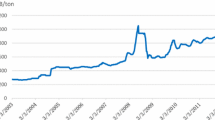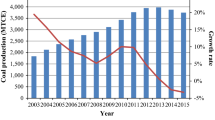Abstract
Coal is essential to ensure China’s energy security. The sudden or gradual change of coal price reflects the degree of disequilibrium or expected disequilibrium of coal supply and demand, which will not be conducive to energy security. Therefore, it is important to analyze the change points of coal price and explore the reason of the price fluctuation. This paper analyses the coal price from January 2008 to June 2019 as the perspective of the financial market. Firstly, the PPM-DBSCAN model is used to identify the mutation point of coal price fluctuation. Secondly, path analysis is used to extract the core driving factors that affect coal price. Thirdly, the authors construct a time-varying and time-lag effect analysis model for structural changes of coal price based on the TVP-VAR model. The results show that there are 11 mutation points of coal price fluctuation. Financial market factors, coal supply and demand and alternative factors are the reasons of coal price mutation. The authors find that the imbalance of coal supply and demand in traditional view cannot fully explain the fluctuation of coal price. The impact of the financial market and non-thermal power generation have more influence on the coal price.
Similar content being viewed by others
References
Page E S, Continuous inspection schemes, Biometrika, 1954, 41(1–2): 100–115.
Sun L J, Sheng W J, and Duan J S, Relationship of China’s stock price and general price: Theoretical and empirical analysis based on FTPL theory and structural change, Test Journal of Financial Research, 2016, (2): 145–153.
Chai J, Zhu Q, Zhang Z Y, et al., Identification and analysis of the breaking point of oil price, China Population, Resources and Environment, 2014, 24(1): 109–117.
Lin B Q and Mao D X, Characteristics of China’s carbon emission intensity in different development stages, Journal of Financial Research, 2014, (8): 101–117.
Chai J, Lu Q Y, Zhou Y H, et al., Analysis and statistical inference of crude oil price change points, Chinese Journal of Management Science, 2017, 25(5): 33–41.
Zhang H and Cheng J H, Dynamic effect of china’s energy price fluctuations and resident consumption levels: Verification based on the VAR model and SVAR model, Resources Science, 2011, 33(5): 806–813.
Guo J, Zheng X Y, and Chen Z M, How does coal price drive up inflation? Reexamining the relationship between coal price and general price level in China, Energy Economics, 2016, 57: 265–276.
Liu X Y and Lin B Q, Reforming the energy pricing mechanism to ensure sustainable development: A case study of coal-power interaction policy, Journal of Financial Research, 2013, (4): 112–126.
Xu X H and Gao H, Empirical research on the impact of China coal price on general GDP price level and related industrial prices, China Population, Resources and Environment, 2014, 24(S1): 155–158.
Mou D G and Lin B Q, Study on the time-varying parameters of China’s economic growth, power consumption and coal prices, Journal of Financial Research, 2012, (6): 42–53.
Jots M and Mignon V, On the link between forward energy prices: A nonlinear panel cointegration approach, Energy Economics, 2012, 34(4): 1170–1175.
Best R, Switching towards coal or renewable energy? The effects of financial capital on energy transitions, Energy Economics, 2017, 63: 75–83.
Mou D G and Wang P Y, Study of endogenous energy prices and monetary policy choice in China, Journal of Financial Research, 2017, (11): 81–95.
Chai J, Guo J E, Meng L, et al., Exploring the core factors and its dynamic effects on oil price: An application on path analysis and BVAR-TVP model, Energy Policy, 2011, 39(12): 8022–8036.
Peng H F and Zhu X Q, Multiple arbitrage motives and shock effects of short-term capital flows: Dynamic analysis based on TVP-VAR, Economic Research Journal, 2019, 54(8): 36–52.
Thorbecke W, How oil prices affect East and Southeast Asian economies: Evidence from financial markets and implications for energy security, Energy Policy, 2019, 128: 628–638.
Sun C W, Ding D, Fang X M, et al., How do fossil energy prices affect the stock prices of new energy companies? Evidence from Divisia energy price index in China’s market, Energy, 2019, 169: 637–645.
Reboredo J C and Ugolini A, The impact of energy prices on clean energy stock prices, A multivariate quantile dependence approach, Energy Economics, 2018, 76: 136–15.
Yuan C Q, Liu S F, and Wu J L, The relationship among energy prices and energy consumption in China, Energy Policy, 2010, 38(1): 197–207.
Liang T, Chai J, Zhang Y J, et al., Refined analysis and prediction of natural gas consumption in China, Journal of Management Science and Engineering, 2019, 4(2): 91–104.
Li J L, Xie C P, and Long H Y, The roles of inter-fuel substitution and inter-market contagion in driving energy prices: Evidences from China’s coal market, Energy Economics, 2019, 84: 104525.
Best R and Burke P J, Adoption of solar and wind energy: The roles of carbon pricing and aggregate policy support, Energy Policy, 2018, 118: 404–417.
Wagner L, Molyneaux L, and Foster J, The magnitude of the impact of a shift from coal to gas under a carbon price, Energy Policy, 2014, 66: 280–291.
Duan R J, On the local tax growth after the tax sharing reform in China, Finance & Trade Economics, 2008, (8): 38–43, 128.
Zhang Y S and Zhang D Q, Interest rate rule with a role of money and its empirical test in China, Economic Research Journal, 2008, 43(12): 65–74.
Feng S X, Jiang F X, Xie Q C, et al., Mechanism and empirical analysis of inflation trends forecasting by financial conditions index — Based on China’s monthly data from 1999 to 2011, China Industrial Economics, 2012, (4): 18–30.
Loschi R H and Cruz F R B, Extension to the product partition model: Computing the probability of a change, Computational Statistics & Data Analysis, 2005, 48: 255–268.
Nakajima J, Time-varying parameter VAR model with stochastic volatility: An overview of methodology and empirical applications, Monetary and Economics Studies, 2011, 29: 107–142.
Barry D and Hartigan J A, Product partition models for change point problem, The Annuals of Statistics, 1992, 20(1): 260–279.
Crowley E M, Product partition models for normal means, Journal of the American Statistical Association, 1997, 92(437): 192–199.
Dipak K D, Sujit K G, and Chang H, Measuring the effect of observations using the posterior and the intrinsic Bayes factors with vague prior information, Sankhy: The Indian Journal of Statistics, 1997, 59(3): 376–391.
Hamilton J D, A new approach to the economic analysis of nonstationary time series and the business cycle, Econometrica, 1989, 57(2): 357–384.
Henriques I and Sadorsky P, Oil prices and the stock prices of alternative energy companies, Energy Economics, 2008, 30(3): 998–1010.
Incln C and Tiao G C, Use of cumulative sums of squares for retrospective detection of changes of variance, Journal of the American Statistical Association, 1994, 89(427): 913–923.
Kilian L, The economic effects of energy price shocks, Journal of Economic Literature, 2008, 46(4): 871–909.
Llop M, Measuring the influence of energy prices within the price formation mechanism, Energy Policy, 2018, 117: 39–48.
Melichar M, Energy price shocks and economic activity: Which energy price series should we be using?, Energy Economics, 2016, 54: 431–443.
Ma Y Q and Wang J H, Co-movement between oil, gas, coal, and iron ore prices, the Austrilian dollar, and Chinese RMB exchange rates: A copula approach, Resources Policy, 2019, 63: 101471.
Quintana F A and Iglesias P L, Bayesian clustering and product partition models, Journal of the Royal Statistical Society B, 2003, 65(2): 557–574.
Song M L and Wang J L, Coal price fluctuations in China: Economic effects and policy implications, Journal of Renewable and Sustainable Energy, 2016, 8(6): 422–431.
Author information
Authors and Affiliations
Corresponding author
Additional information
This research was supported by the National Natural Science Foundation of China under Grant No. 71874133 and “Special Support Program for High-Level Talents” Youth Top Talent Program of Shaanxi Province, China.
This paper was recommended for publication by Editor WANG Jue.
Rights and permissions
About this article
Cite this article
Chai, J., Lei, J., Shi, H. et al. Analysis on the Mutation and Time-Varying Characteristics of Coal Price System Evolution from the Perspective of Finance. J Syst Sci Complex 34, 1501–1521 (2021). https://doi.org/10.1007/s11424-020-0061-5
Received:
Revised:
Published:
Issue Date:
DOI: https://doi.org/10.1007/s11424-020-0061-5




